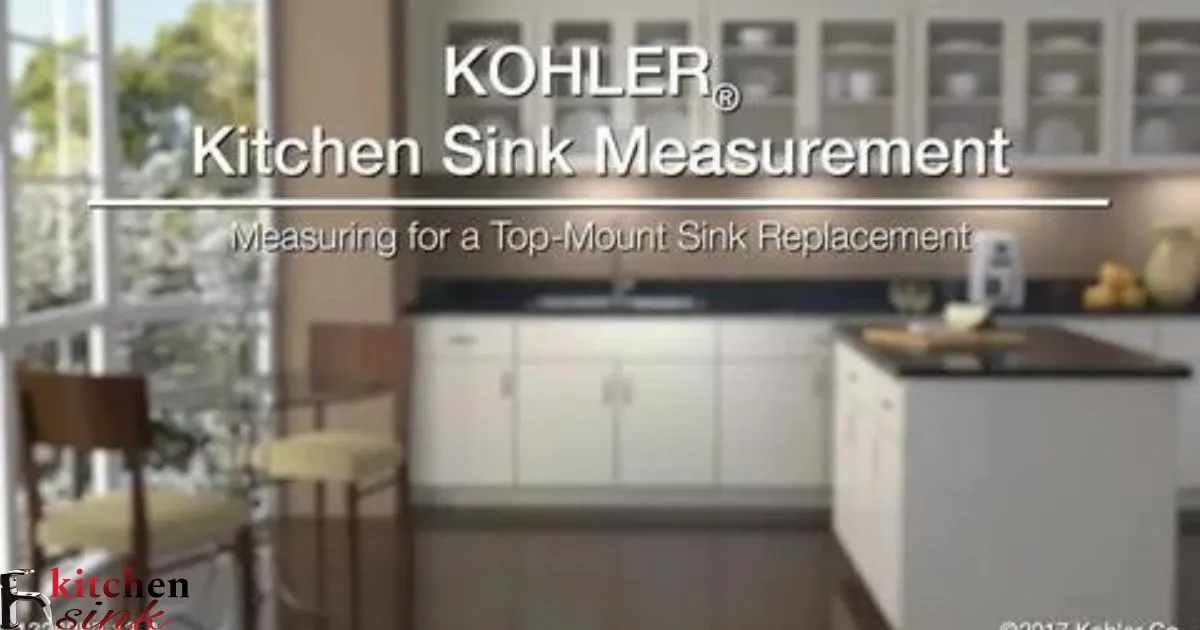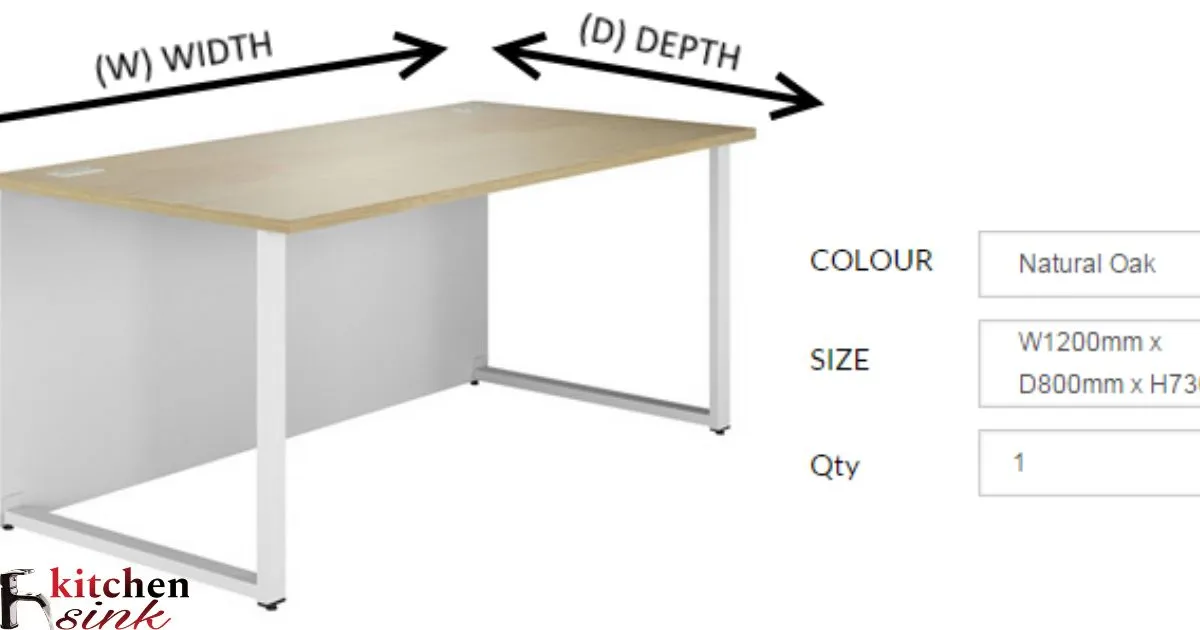Measuring for a kitchen sink involves taking accurate dimensions of the space where the sink will be installed. This ensures getting a sink that fits properly in the countertop cutout without any issues.
How to measure for a kitchen sink can seem confusing but taking the right measurements makes installation so much easier. Following simple steps like measuring the width, depth and location of the sink cutout will allow getting a sink that is the perfect size for the space.
When measuring for a kitchen sink, first measure the width of the sink base cabinet opening where the sink will sit. Then measure how far back the sink needs to sit from the front of the cabinet. Additional measurements of the depth and possible install locations provide all details needed for a seamless sink installation. Taking time for accurate measurements results in a well-fitting sink.
Measuring The Cabinet Space For Your Kitchen Sink
The first step in measuring for a kitchen sink is examining the cabinet it will sit inside of. Take measurements of the full opening for the sink base cabinet to ensure an accurate size. Knowing exact dimensions prepares for finding the right fitting sink.
Check that there is sufficient depth, width and space inside the cabinet where the sink will be installed. Clearances are needed around the sink for tasks and cleaning. Good measurements result in a sink that has room to be used easily.
What Is The Width Of The Cabinet Opening For The Kitchen Sink?
The width of the cabinet opening where the kitchen sink will be installed needs to be accurately measured. This determines the maximum width sink that can fit in the existing space.
A table with measurements makes the findings easy to reference:
| Cabinet Opening Width | Sink Width Options |
| 24 inches | 24 inch sinks |
| 25 inches | 24-25 inch sinks |
| 30 inches | 24-30 inch sinks |
| Odd shape | Measure each section carefully to find the largest width sink that will fit fully |
Taking width measurements at both the front and back ensures the opening is consistent. Any differences in numbers means an uneven opening requiring a specially measured sink for proper fit. The table helps select sink widths that fit within the actual cabinet parameters.
How Wide Is The Sink Base Cabinet?
Measure from the inside edge of one cabinet side to the other being careful only to measure actual flat surfaces. Do not include knobs or hardware that protrude.
Record this number to ensure any chosen sink falls within the actual useable cabinet interior space and does not hit fixtures. Correct width measurements allow getting a sink that fits tightly.
Is The Opening Square Or Odd Shaped?
Examine all edges and angles of the cabinet opening to note if corners are square or have odd angles. Consider if the space is a regular rectangle or another shape.
Any unusual shapes need additional measurements taken. Note findings so the right sink can be chosen for the particular space configuration. Properly shaped sinks fit better in irregular openings.
Determining If The Opening Needs To Be Enlarged
Check local codes for any size requirements of the sink or cabinet opening. Compare numbers to existing measurements to determine if expansion is permitted.
Enlarging structural walls or altering plumbing can add cost. Measure carefully before deciding to stay with current sizes or modify the space for a sink.
How Deep Does The Kitchen Sink Need To Sit?
Depth is important to allow the sink to properly drain. Most sinks require a minimum depth of 22 inches from the wall or front of the counter.
Take measurements inside the cabinet front to back being careful only to record actual useable space depth without obstructions. Compare to minimum sink standards.
Sink Depth Requirements
Sinks have requirements for a set depth in order for plumbing, drain assemblies and dishes to fit correctly. Undermount sinks typically need 24-25 inches minimum.
Record any obstructions such as pipes or crossbeams that limit actual usable depth space inside the cabinet. Special clearances may be needed under these structures.
Allowing Space For Piping And Drain Installation
Behind the sink, Measure Is A Kitchen Sink space is necessary for pipes and drain trap assembly fittings. Most require 3-4 inches from rear cabinet wall or backsplash.
Leave room in depth measurements for cleanouts, shutoffs and other connections which add thickness behind the installed sink. Proper clearances assist plumbing installation.
Common Kitchen Sink Depths
5 common kitchen sink depths in easy, short sentences
- Eight inches – A standard depth for many basic drop-in sinks. Fits easily in standard base cabinets. Provides room below rim for washing.
- Nine inches – Also common for affordable sinks. Slightly more depth aids washing larger pots and dishes. Still fits most undermount cabinet spaces.
- Ten inches – A generous washing well for larger families. Accommodates full size pans. May require custom cabinet to fully fit this depth.
- Six inches – More rare, but an option. Useful for restricted cabinet depths. Best for small households or infrequent use. Offers shallow washing area.
- Twelve inches – A luxury choice. Provides abundant depth for soaking or cleaning large items. Needs specific planning for extra deep cabinet installation.
Will The Sink Fit In The Cabinet Depth?
Compare depth measurements to sink requirements checking for obstructions or undocumented structural parts. Minimums are needed but extra room improves ease of use and cleaning access.
Carefully recorded depth ensures the proper sink can be chosen that fits within available space while meeting necessary clearances. Proper fit avoids future remodeling costs.
Taking Measurements For The Best Fit Kitchen Sink
Proper measurements allow choosing from different sink options. Take all important details to ensure the ideal sink selection for the space and needs. Careful steps now lead to perfect fit later.
Recording multiple sizes accounts for inaccurate tools or eyes. Double checking creates flexibility if slightly off found during installation. Proper notes simplify finding exactly matching sinks.
Which Sink Installation Type?
Consider if a sink will be drop-in style, sitting on the countertop, or an undermount fully inset into the stone. Mounting impacts dimensions and clearances required around rim.
Note findings to correctly source a sink style suited for the project. Compatibility with existing space decides what options can realistically be chosen from.
Drop-In Or Undermount Kitchen Sink?
Undermount sinks need precise cutouts while drop-ins give more forgiveness. For undermount take very accurate top-view measurements of the sink hole area in the counter.
Recording installation factors streamlines shopping and prevents buying incompatible sinks. Research each mounting method’s specific measurement needs.
Single Or Double Bowl Sink Choice
Decide if one or two compartments are desired based on tasks. Measure bowls individually if choosing double. Note size and placement of dividing bars.
Gather clear dimensions to easily match sinks during selection. Numbers confirm space for chosen bowl quantity and configuration options.
Considerations For Large Or Small Sinks
Note any size restrictions and check maximum measurements will fit through doors to the space. Compare to dimensions of planned cleaning and food preparation equipment usage.
Recording these specifics selects a sink truly suited for the job rather than one squeezing awkwardly in the opening. Proper sizing avoids regrets.
Where Will The Kitchen Sink Be Located?
Placing a sink in a corner requires extra depth and width clearances on two sides. Note if centered or offset within the overall cabinetry.
Location impacts available space on all adjoining surfaces. Draw a rough sketch and take detailed notes of the proposed sink site.
Wall Corners Or Cabinet Centers
Record whether the sink will sit flush against a wall corner inside cabinets or be more centralized within the overall footprint. Each placement has unique needs.
Noting the location streamlines confirming clear dimensions and ensures compatible sink options are assessed that properly fit within the allocated space.
Plumbing And Drain Locations
Note if pipes enter from below or the sides. Consider access required for hookups. Mark plumbing locations on sketches for reference during installation.
Prepare rough area outlines to simplify measurements and help plan clearances when choosing the right sink for the site specifics.
Ensuring Clearances Around The Sink
Leave extra inches for working, cleaning and elbow room around all sink perimeters. Note any specific clearance minimum standards set by codes.
Proper allowances account for comfortable usability. Measure generously rather than tightly to prevent bumping installed fixtures.
Using The Measurements To Find The Right Kitchen Sink
Organized paperwork and sketches guide finding exactly compatible sinks. Review numbers versus options and confirm before purchasing.
Double check measurements against sink dimensions online or in stores. Clear communication ensures the ideal sink is chosen based on the space’s recorded needs.
What Dimensions To Check For The Sink?
At minimum note the necessary sink width, depth, number of bowls, and special requirements like extra plumbing access space.
Carefully recorded details allow cross-referencing during selection. Consider all sink components to guarantee proper fit.
Width, Depth, Number Of Bowls
Specifically measure and note the sink inside widths and depths, including dividing bars if applicable. Compare bowl counts to needs and space.
Double checking the primary sink numerical requirements guides selection of the best sized and styled option. Proper fit avoids costly replacements.
Special Sink Features To Confirm
Some sinks have specific dimension needs for accessories. Note grated areas, extended ledges or other parts requiring careful clearance considerations.
Accounting for full sink package details simplifies getting exact compatibility. Special measurements avoid disrupting plans.
Leaving Room For Error In Measurements
Allow extra space in figures to account for imperfect measuring tools. Note that precise cuts and drilling also have small variances to tolerate.
Building in flexibility from the start eases installation hassles. Margins for error smooth the process.
Frequently Asked Question
What Is The Most Important Measurement?
The width of the cabinet opening where the sink will sit is key to ensure the new sink will fit properly.
Should Inside Or Outside Measurements Be Taken?
Measure only the actual usable space to get an accurate dimension without hardware or obstructions that could impact the sink size needed.
Why Measure The Depth Twice?
Checking at both the front and back confirms if the depth remains consistent or if fixtures need consideration.
What If The Opening Isn’t Square?
Irregular openings require additional detailing of angles, widths and lengths to find a sink contour that sits evenly without forcing.
How Closely Must The Planned Sink Size Match Measurements?
Allow small margins of error in sizing to compensate for any miscalculations while installing but choose as closely as possible to the documented room available.
Conclusion
Taking accurate How To Measure For A Kitchen Sink? is important for getting the right size and fit. Following the steps ensures that the new sink matches the existing space perfectly without issues. With correct measurements, installation goes smoothly without problems.
Proper documentation of all details like the width, depth, and any odd shapes or fixtures helps when selecting a new How To Measure For A Kitchen Sink? that fulfills the space needs. Being thorough in measuring simplifies finding the ideal sink match based on the room’s recorded specifications. Careful measurements result in a well-installed sink that functions properly for years of use.



